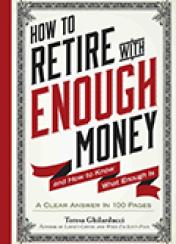
Teresa Ghilarducci, a labor economist and professor at the New School for Social Research, is not inclined to exert herself in supporting the interests of the affluent. If anything, it’s the reverse.
In How to Retire with Enough Money: And How to Know What Enough Is, her book coming out December 15 from Workman Publishing Co., Ghilarducci recommends using tax credits, rather than tax deductions, to reward people for retirement saving. Her reasoning: Tax deductions are more valuable to high-income payers. Likewise, she says eliminating the cap on incomes subject to Social Security withholding, currently indexed at $118,500, is a desirable way to more fully fund the Social Security reserves.
Ghilarducci, who is also an adviser to public pension funds, has portrayed banks and brokers as having “armies of lobbyists” that have worked to impede federal adoption of the Guaranteed Retirement Account (GRA), a type of retirement account she first proposed in 2007 to replace the 401(k)s and IRAs that she says have failed in their purpose of enabling people to fund their own retirement.
Only the last few pages of this slim volume discuss GRAs. The rest is a basic guide to retirement saving for low- and middle-income individuals and contains recommendations to delay taking Social Security benefits until age 70 and other familiar advice. But it’s clear that the author regards the GRA as her primary intellectual contribution to retirement planning — and the best and only likely solution to the retirement crisis.
As Ghilarducci describes it, the overall retirement picture is indeed grim. She points to, among other things, data showing most Americans over age 50 have only $30,000 in retirement savings, when $1 million is needed. As things stand, she says, half of Americans will live in or near poverty after retirement, with an average food budget of $5 a day.
Her essential point is that the do-it-yourself retirement savings experiment, which began in 1978 with 401(k) tax-deferred retirement plans, has failed. People don’t save enough, Ghilarducci says, and they don’t invest wisely enough. They borrow from already inadequately funded retirement accounts and pay too much in sales commissions and management fees. She doesn’t blame ordinary savers for this. She notes that retirement planning, although simple in concept, is difficult in execution.
Her prescription is a nationwide mandatory savings plan. Every earner would put 2.5 percent of earnings into the plan, and employers would match these amounts. Funds would be invested in low-cost index funds selected by private sector managers chosen by federal officials.
GRA returns would be guaranteed at an inflation-adjusted 3 percent per year, Ghilarducci specifies. Unlike with IRAs and 401(k)s, the money would not be available until retirement, when retirees would begin receiving inflation-indexed annuity payments sufficient to allow them to live in comfort without the fear of running out of money.
GRA would work alongside Social Security. The combination of 12.8 percent in Social Security payroll withholding, including both employees’ and employers’ halves, plus 5 percent combined contribution to the GRA, would force savers to put away 17.8 percent. This figure is in the sweet spot of the 15 to 20 percent of earnings considered sufficient for retirement saving. “An elegant solution to our retirement savings crisis,” she writes.
After 40 years of work and contributions, GRA-funded annuity payments would replace about 30 percent of the typical retirees’ preretirement income. As things currently stand, Social Security supplies approximately 40 percent of preretirement income for many U.S. retirees. Thus, together, the two sources would replace 70 percent or so of preretirement income, a figure often suggested as adequate for comfortable retirement.
Ghilarducci doesn’t say exactly how enactment of the GRA would affect current IRAs and 401(k)s, other than to “have the entire financial industry reaching for antacids.” Many people outside financial services object to the idea, as some don’t like the mandatory aspect, she notes. Others worry about not being able to access funds before retirement. Many would-be investors are simply uneasy about handing money to the government.
With those objections in mind, state-level GRA-like retirement plans have been enacted or are being considered by some states. California, for instance, in 2012 passed its Secure Choice Retirement Savings Program, which will operate much like a GRA, though one difference is that people will be able to opt out of it. The California plan must meet several requirements before it actually goes into operation, however. One is determining whether federal income taxes on contributions can be deferred. Studies on those questions are under way.
Ghilarducci makes some hard-to-refute points about the challenges of having individuals responsible for voluntarily funding their own retirement. She plainly lays out what workers need to do — save more, invest wisely — and proposes a government program that would force them to do just that. The financial advice is nothing new. The government program has been proposed before. Meanwhile, a near majority of future retirees still contemplates eating on $5 a day. How to retire with enough money remains a puzzle relatively few people have solved.






